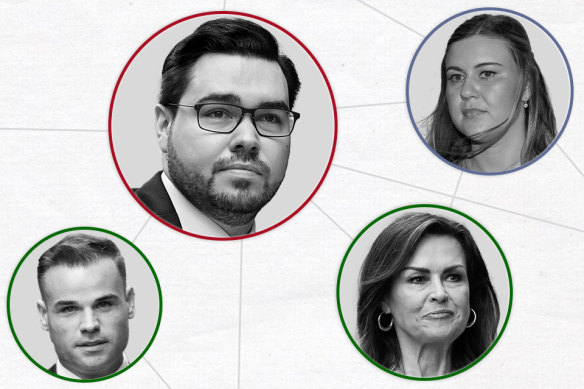This was published 1 year ago
Opinion
So much litigation, so little clarity: The Lehrmann case is a sordid labyrinth
Jacqueline Maley
Columnist and senior journalistOn Thursday, about 27,000 people watched the online stream of the defamation trial brought by Bruce Lehrmann against Network Ten and its former star journalist, Lisa Wilkinson. Truth is stranger than fiction, and often more entertaining, although the objective truths of the Higgins/Lehrmann matter grow ever more obscure with each fresh piece of litigation.
The defamation trial was dramatically reopened – just days before a judgment on the matter was expected from Justice Michael Lee – to hear evidence from former Channel Seven producer Taylor Auerbach.

Artwork — Kathleen Adele Credit:
It’s hard to imagine how the evidence could have been any more sordid. Auerbach told the court that Seven paid for prostitutes, dinners and even cocaine in an effort to secure an exclusive interview with Lehrmann. Seven put out a statement denying any corporate knowledge of the unusual expenses. Lehrmann’s barrister attacked Auerbach’s credibility and motivations.
If you’ve lost the narrative thread, don’t beat yourself up. It’s hard to remember how any of it is relevant to the original defamation action, let alone the matter Lehrmann is suing over – Higgins’ claim in a February 2021 television interview with Wilkinson that she was raped by a colleague in Parliament House.
Lehrmann was not named in that interview, on Network Ten, but he argues he was identifiable anyway. He was later tried for the rape, but the trial was abandoned due to juror misconduct. He vehemently denies the allegation.
Justice Lee seemed conscious of the wild turns the case was taking when he presided over the second part of Auerbach’s evidence on Friday. “I am just concerned how far we are going down what is looking like a rabbit hole,” he said at one point. “I want to put this back in a box.”
Lee was referring to the people Auerbach was mentioning in his evidence, including his former bosses at Seven. Auerbach is a self-confessed disaffected ex-employee who admits he “hates” his former boss. Lee made the point that the people he was traducing in his evidence didn’t have a chance to defend themselves.
But it’s too late for any of this to go back into the box, so to speak. The whole saga long ago jumped the shark, and it’s about as awful as it gets in terms of human behaviour and the personal desolation of all involved.
But people are very interested in it. It is the source of huge media attention, many arguments and much opinion. It has damaged the careers and reputation of former ACT director of public prosecutions Shane Drumgold, former judge Walter Sofronoff (who led an inquiry into Lehrmann’s prosecution for rape) and outgoing Liberal senator Linda Reynolds, in whose office the alleged rape took place.
Reynolds has mounted her own defamation action against Higgins and Higgins’ partner David Sharaz, for social media posts they made after the whole thing came to light.
It’s hard to remember this was once a Canberra story, which played a significant part in the electoral unpopularity of former prime minister Scott Morrison, and led to a review and eventual overhaul of the culture of Parliament House.
The case captures people’s interest because it has at its heart two divisive issues.
The first is the treatment of sexual assault in the justice system and in the media post-#metoo. Everyone has an opinion on the motives and conduct of Lehrmann and Higgins, and in the remarks he has made so far, Justice Lee has indicated he has possible doubts about the credibility of both. He has said that parts of the evidence of both Lehrmann and Higgins “simply can’t be accepted”.
The second issue the case has highlighted is the role of the media in bringing alleged injustice and wrongdoing to light, and the tactics some journalists use to get stories in a competitive environment. No journalist has come out of the whole matter looking good, but then no one at all has come out of it looking good.
It has pitched Channel Seven against Channel Ten, and embroiled a journalist from The Australian in relation to the Sofronoff probe. (Sofronoff’s meetings with that journalist were found by the ACT Supreme Court to have given rise to an impression of bias.)
The defamation action brought by Lehrmann to defend his reputation has been an epic own goal. What has been alleged about Lehrmann’s behaviour – his alleged use of sex workers and cocaine, and his love of what Auerbach calls “benders” – has further damaged his reputation.
Channel Seven faces allegations that, at best, it fostered a very unhealthy workplace culture, according to Auerbach’s evidence. The network has put out a statement saying it acted appropriately at all times.
Auerbach admitted in the witness box to disseminating to journalists a photo of a naked woman with his former producer-boss and sworn enemy, Steve Jackson, in an effort to smear Jackson. Matthew Richardson SC, acting for Lehrmann, put to him that he did that without the consent of the woman, and it constituted a criminal act. (Auerbach claimed he did not know that.) It was certainly a vile act.
The misogyny and vulgarity inherent to all these claims and counter-claims is enough to make you weep. And that’s before you get to the allegations, denied by Lehrmann, that he leaked Higgins’ personal information to media, in breach of legal obligations to keep such evidence within the bounds of the original criminal trial.
Whoever was responsible for it, the invasion of Higgins’ privacy is a bone-chilling warning to any prospective rape complainant, and a perpetuation of perceptions that there are “good” alleged rape victims and bad ones, and the bad ones will be fair game.
The matter has been so heavily litigated, yet it has brought no satisfaction to any party involved.
Jacqueline Maley is a regular columnist.